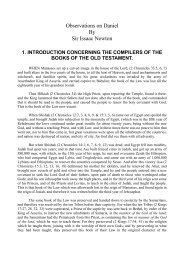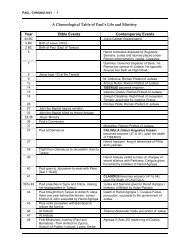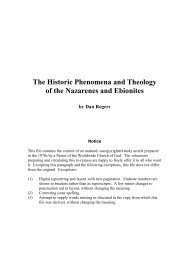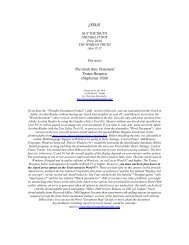Legends of the Shawangunk2 JR.pdf - Friends of the Sabbath ...
Legends of the Shawangunk2 JR.pdf - Friends of the Sabbath ...
Legends of the Shawangunk2 JR.pdf - Friends of the Sabbath ...
You also want an ePaper? Increase the reach of your titles
YUMPU automatically turns print PDFs into web optimized ePapers that Google loves.
168 <strong>Legends</strong> <strong>of</strong> <strong>the</strong> Shawangunk.<br />
alive. But <strong>the</strong> way out <strong>of</strong> <strong>the</strong> difficulty was reached in an unexpected manner. The<br />
second husband went from home, ostensibly on business, and a few days afterward his<br />
hat and some <strong>of</strong> his clothing were found on <strong>the</strong> banks <strong>of</strong> <strong>the</strong> Delaware. Whe<strong>the</strong>r he really<br />
committed himself to <strong>the</strong> mercy <strong>of</strong> <strong>the</strong> water with suicidal intent, or only sought to<br />
convey <strong>the</strong> impression that he was dead, while he left for parts unknown, has never been<br />
told. Those who knew him best incline to <strong>the</strong> view that, from motives <strong>of</strong> compassion for<br />
<strong>the</strong> feelings <strong>of</strong> his family, he chose <strong>the</strong> latter alternative. Major Wood lived many years<br />
after his return, and his descendants are held in high estimation at <strong>the</strong> present time.<br />
One <strong>of</strong> <strong>the</strong> greatest curiosities, in point <strong>of</strong> <strong>the</strong> mysteriousness <strong>of</strong> its origin in <strong>the</strong><br />
county <strong>of</strong> Ulster, is that bit <strong>of</strong> ancient masonry in <strong>the</strong> town <strong>of</strong> Plattekill known as <strong>the</strong><br />
“Indian Dam.” It is located on what is known as <strong>the</strong> Levi Bodine farm, now occupied by<br />
J. S. Terwilliger, jr. The dam in question consists <strong>of</strong> two stone walls joined at an obtuse<br />
angle, and is about one hundred and fifty yards in length, eight or ten feet in height at <strong>the</strong><br />
highest part, and four feet in width at <strong>the</strong> top. It is built across a stream at <strong>the</strong> outlet <strong>of</strong> a<br />
heavily timbered swamp, and would submerge about one hundred acres. As <strong>the</strong>re is<br />
scarcely any perceptible fall, <strong>the</strong> dam could hardly have been built to furnish water<br />
power, hence <strong>the</strong> question as to <strong>the</strong> purpose <strong>of</strong> its construction has never been<br />
satisfactorily answered. What is stranger still, when <strong>the</strong> first settlers came into <strong>the</strong><br />
vicinity, more than a century ago, <strong>the</strong> dam was <strong>the</strong>re in <strong>the</strong> same condition in which it is<br />
now found; nor could <strong>the</strong>y ascertain when, by whom, or for what purpose it was built.<br />
Though called <strong>the</strong> Indian Dam, it is not probable <strong>the</strong> Indians had anything to do with its<br />
construction, as <strong>the</strong>y were not given to wall building. Its origin may have been coeval<br />
with that <strong>of</strong> <strong>the</strong> ancient roads in <strong>the</strong> vicinity <strong>of</strong> <strong>the</strong> Shawangunk mountain, called <strong>the</strong><br />
“Mine Roads,” indications <strong>of</strong> which may yet he seen at various points at <strong>the</strong> foot <strong>of</strong> <strong>the</strong><br />
declivities on ei<strong>the</strong>r side, <strong>of</strong> which nei<strong>the</strong>r history nor tradition can give a satisfactory<br />
account.
















